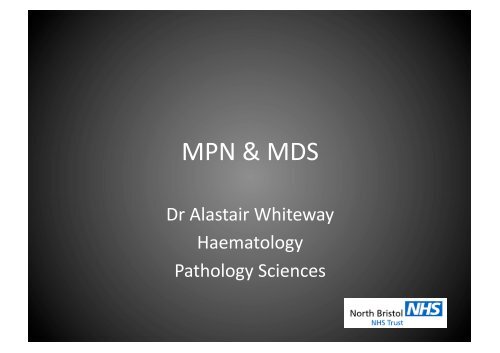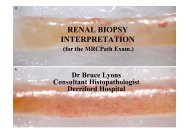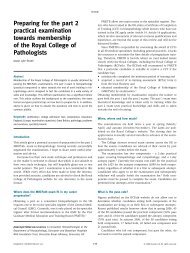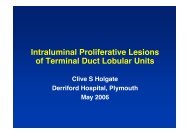Myeloproliferative and dysplastic disorders - Pathkids.com
Myeloproliferative and dysplastic disorders - Pathkids.com
Myeloproliferative and dysplastic disorders - Pathkids.com
Create successful ePaper yourself
Turn your PDF publications into a flip-book with our unique Google optimized e-Paper software.
MPN & MDS <br />
Dr Alastair Whiteway <br />
Haematology <br />
Pathology Sciences
Incidence of malignancies in the <br />
UK <br />
Cancer Research UK / NICE IOG manual
Why Classify? <br />
• “Language of medicine: diseases must be <br />
described, defined <strong>and</strong> named before they can <br />
be diagnosed, treated <strong>and</strong> studied” <br />
• Disease should be clinically disIncIve <strong>and</strong> <br />
non-‐overlapping <br />
• Out<strong>com</strong>e <br />
• Therapy <br />
• Advance knowledge
Basis of WHO 2008 ClassificaIon <br />
Clinical <strong>and</strong><br />
laboratory<br />
features<br />
DIAGNOSIS <br />
Morphology &<br />
immunophenotype<br />
Cytogenetics &<br />
molecular genetic findings
Pre-‐requisites: peripheral blood <br />
• RBC indices from automated analyzer <br />
• Good quality May-‐Grunwald-‐Giemsa or Wright-‐<br />
Giemsa stain is necessary <br />
• RBC indices from automated analyzer <br />
• Manual 200 cell differenIal re<strong>com</strong>mended in <br />
myeloid neoplasms
Pre-‐requisites: <br />
bone marrow aspirate <br />
• Good quality aspirate with adequate parIcles <br />
• Well spread -‐ too thick or thin smear is inadequate <br />
• High quality staining is essenIal <br />
• Do not over diagnose on aspirate <br />
• Cellularity difficult to assess <br />
• 500 nucleated cell differenIal count in area close <br />
to parIcles
LeukaemiaNet WP9.6
MyeloproliferaIve Neoplasms <br />
• CML, BCR-‐ABL1 posiIve* <br />
• Polycythemia vera* <br />
• EssenIal thrombocythaemia* <br />
• Primary myelofibrosis* <br />
• Chronic neutrophilic leukaemia <br />
• Chronic eosinophilic leukaemia NOS <br />
• Mastocytosis <br />
• MyeloproliferaIve neoplasm, unclassifiable
BCR-‐ABL signalling in chronic <br />
myeloid leukaemia
Jak2 in signal transducIon <br />
• Protein tyrosine kinase <br />
of the non-‐receptor <br />
type <br />
• Associates with the <br />
intracellular domains of <br />
cytokine receptors <br />
• JAK2 is the <br />
predominant JAK kinase <br />
acIvated in response to <br />
several growth factors
Molecular basis of Ph’-‐negaIve <br />
MPN <br />
• Polycythemia vera: <br />
– ~95% JAK2(V617F); ~2-‐3% JAK2 exon 12 <br />
• Essen=al thrombocythemia: <br />
– 50-‐60% JAK2(V617F); ~5% MPL exon 10 <br />
• Primary myelofibrosis: <br />
– 50-‐60% JAK2(V617F); 5-‐10% MPL exon 10
DiagnosIc algorithm for CML, PV, ET & PMF <br />
Tefferi, A. et al. (2009)<br />
Nat. Rev. Clin. Oncol.
Eosinophilia, monocytosis, <br />
mastocytosis <br />
Tefferi, A. et al. (2009)<br />
Nat. Rev. Clin. Oncol.
MDS vs MPN <br />
• MDS <br />
• Cytopenias <br />
• IneffecIve <br />
haematopoiesis <br />
• Dysplasia <br />
• No splenomegaly <br />
• Risk of transformaIon <br />
to AML <br />
• cMPN <br />
• Normal or elevated <br />
blood counts <br />
• EffecIve <br />
haematopoiesis <br />
• No dysplasia <br />
• Splenomegaly <br />
• Risk of transformaIon <br />
to AML
MDS/MPN <br />
• CMML (CMML with eosinophilia) <br />
• Atypical CML, BCR-‐ABL1 NEGATIVE <br />
• JMML <br />
• MDS/MPN, unclassifiable <br />
• Refractory anemia with ring sideroblasts <strong>and</strong> <br />
thrombocytosis (RARS-‐T) -‐ provisional enIty
Atypical CML <br />
• ↑WBC with mature <strong>and</strong> maturing <br />
granulocytes <br />
• Low percent of monocytes <br />
• Includes rare cases of BCR-‐ABL negaIve <br />
leukaemia <strong>com</strong>prised of mature <strong>and</strong> maturing <br />
granulocytes <br />
• High leukocyte count MDS or chronic <br />
myeloproliferaIve syndrome with <br />
myelodysplasIc features
CHRONIC MYELOMONOCYTIC <br />
LEUKEMIA <br />
• Monocytosis >1.0 X 10 9 /L <br />
• No Ph’ chromosome or BCR/ABL <br />
• 3 months old & <br />
other causes excluded <br />
• Splenomegaly in 30 to 50% of cases
MDS/MPD, UNCLASSIFIABLE <br />
• Features of MDS but with thrombocytosis <br />
(>600 X 10 9 /L) or leukocytosis (>13.0 X 10 9 /L) <br />
• (<strong>and</strong>) No prior history of MDS or MPD <br />
• (<strong>and</strong>) No cytogeneIc abnormality associated <br />
with a specific myeloid disorder <br />
• (or) Mixed MDS <strong>and</strong> MPD features <strong>and</strong> cannot <br />
be assigned to any other category
MyelodysplasIc Syndromes <br />
• Blood cytopenias <br />
• IneffecIve hematopoiesis <br />
• Dyserythropoiesis <br />
• Dysgranulopoiesis <br />
• Dysmegakaryopoiesis <br />
• Increased myeloblasts <br />
• Progressive marrow failure <br />
• Risk of AML
MDS: pre-‐requisites <br />
• Well stained PB <strong>and</strong> BM essenIal <br />
• Dysplasia in >10% of cells in lineage <br />
• Blast % important <br />
• GeneIcs also very important in diagnosis <strong>and</strong> <br />
• prognosis <br />
• Always look for ring sideroblasts under oil <br />
• Detailed history is m<strong>and</strong>atory <strong>and</strong> drug/toxin <br />
exposure <strong>and</strong> B12/folate deficiency must be <br />
excluded. Consider copper...
BM trephine in MDS <br />
• Assessment of cellularity <br />
• Assess disrupIon of architecture <strong>and</strong> focal <br />
collecIon of blasts <br />
• Assess haematopoieIc dysplasia – parIcularly <br />
megakaryocytes <br />
– EssenIal in fibroIc BM <br />
• Immunohistochemical stains, i.e., CD34
DifferenIal diagnosis <br />
• Non-‐neoplasIc causes of myelodysplasia <br />
– MegaloblasIc changes <br />
– Toxic agents, i.e., heavy metals, acute alcohol <br />
– Drug effects -‐ primarily anI-‐neoplasIc <br />
– Congenital dyserythropoieIc anaemia <br />
• Chronic infecIous disease <br />
– HIV <br />
• NeoplasIc Diseases <br />
– Chronic myeloproliferaIve disease <br />
– Acute myeloid leukaemia
Summary of WHO categories <br />
Type <br />
PB blasts <br />
(%) <br />
BM blasts <br />
(%) <br />
RS <br />
(%) <br />
Monos <br />
Dysplasia <br />
RA 0
MDS: RA
MDS: RARS
MDS: RCMLD
Blasts, promyelocytes, abnormal <br />
promyelocytes <br />
Mufti, G. J. et al. Haematologica<br />
2008;93:1712-1717
InternaIonal PrognosIc Scoring <br />
System <br />
Score value <br />
PrognosIc value 0 0.5 1.0 1.5 2.0 <br />
Bone marrow blasts, % < 5 5 -‐ 10 – 11 -‐ 20 21 -‐ 30 <br />
Karyotype Good Intermediate Poor – – <br />
Del 5q Sole 1 other MulIple – – <br />
Cytopenias, n 0 -‐ 1 2 -‐ 3 – – – <br />
IPSS total score 0 0.5 -‐ 1.0 1.5 -‐ 2.0 ≥ 2.5 <br />
IPSS Risk category Low Intermediate-‐1 Intermediate-‐2 High <br />
25% progression to AML <br />
if no therapy, yr <br />
9.4 3.3 1.1 0.2 <br />
Survival, yr 5.7 3.5 1.1 0.4 <br />
Good:normal,-Y,del(5q),del(20q). Poor:<strong>com</strong>plex (>3 abnormalities)<br />
or chromosome 7 anomalies. Intermediate:other abnormalities<br />
Greenberg P, et al. Blood. 1997;89:2079-2088<br />
Erratum 1998
MDS with isolated del(5q) <br />
• Refractory macrocyIc <br />
anaemia <br />
• Thrombocytosis <br />
• Hypolobulated <br />
megakaryocytes <br />
• Stable clinical course <br />
• Resposive to <br />
lenalidomide








